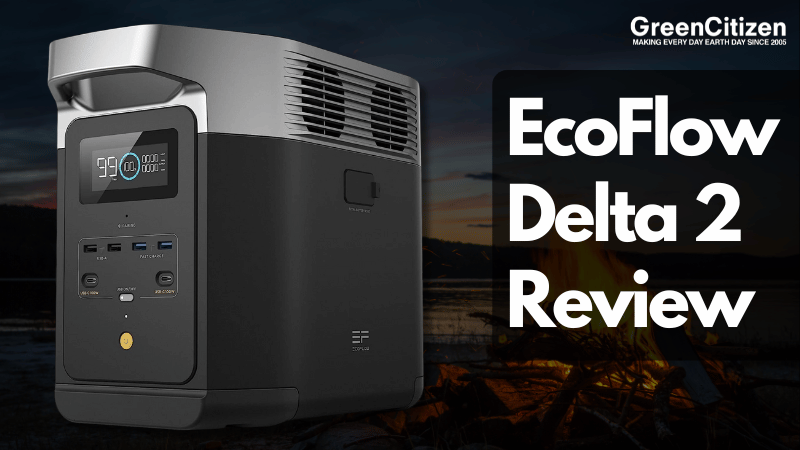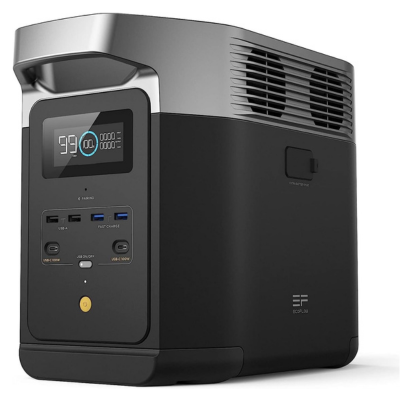I’ve been on enough camping trips to know that losing power is a real mood killer. There’s nothing like a dead phone in a thunderstorm to make you rethink your life choices—and your gear.
Sure, some purists enjoy going completely off-grid. But when you’re on a long trip, you’ll want a simple power outage solution that can keep essential home appliances, cameras, and even a coffee maker covered.
Enter the EcoFlow Delta 2: a 1kWh powerhouse with solar compatibility and a modular design that lets you ‘expand capacity’ for days off-grid or nights without grid power.
But does it live up to the hype?
I hauled the Delta 2 to Colorado’s backcountry, where sunshine and downpours traded blows—a perfect test for its ‘all-weather’ claims. Could it actually power a portable AC, keep a fridge running, and charge up via solar panels as efficiently as advertised?
Or is it just another overpriced battery pack?
This isn’t just a spec sheet rundown—I’ll be sharing my real-world experience, looking at how it compares to other power stations, and breaking down whether it’s a good deal or just a flashy piece of gear.
Let’s dive into what the Delta 2 can (and can’t) do when put through the paces of outdoor life.
EcoFlow Delta 2: Key Features and Real-World Performance
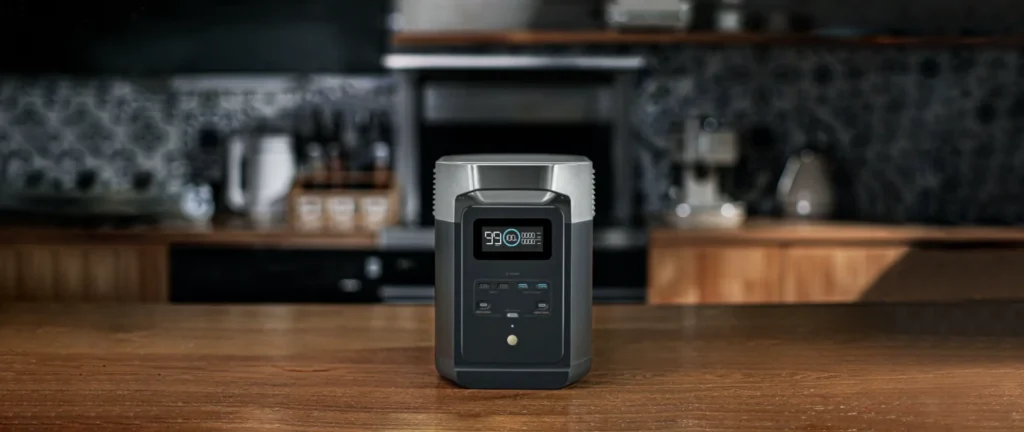
Unboxing & First Impressions
When the EcoFlow Delta 2 arrived at my doorstep, I was quite impressed. It looks exactly like the previous Delta 1300 and Delta Pro—which I really loved. I mean, if it’s not broken, don’t change it, right?
Inside, the unit itself felt surprisingly robust yet compact, with a matte-black finish and rubberized corners that screamed durability.
The package included the Delta 2 unit, a solar charging cable, a car charger, and an AC adapter—all neatly organized with minimal plastic waste. EcoFlow’s “plug-and-play design” lived up to its promise: I had the device powered up and charging my phone within minutes, no manual required.
But let’s talk portability.
EcoFlow markets the Delta 2 as “portable,” and at 27 pounds, it’s lighter than many competitors. However, hauling it uphill to my campsite with a 220W solar panel in tow was no picnic. The built-in handle helped, but after a half-mile trek, I was cursing under my breath.
For car camping? Perfect. For backpacking? Stick to a power bank.
EcoFlow markets this as a “one-stop power solution”, and the numbers on paper sound impressive:
- 1,024Wh battery capacity (expandable to 3,000Wh with extra batteries).
- 1,800W output, with X-Boost Technology pushing it to 2,400W, meaning it can run everyday appliances, including an air fryer, microwave, or even a wave portable air conditioner.
- LiFePO4 battery chemistry, which boasts a battery cycle life of 3,000+ cycles—significantly outlasting traditional lithium-ion batteries.
One of its biggest selling points is solar power integration, thanks to its Maximum Power Point Tracking (MPPT) technology. This system helps the Ecoflow Delta 2 optimize solar charging efficiency, adjusting to sunlight levels for a steady charge.
Theoretically, you can charge it fully in 2-3 hours with portable solar panels, making it ideal for long camping trips or off-grid adventures.
But does it actually live up to these claims?
1. Battery Capacity & Expandability: How Long Does It Really Last?
The Ecoflow Delta 2 comes with a 1,024Wh battery capacity, which can be expanded up to 3,000Wh using smart extra batteries. In theory, this should mean enough energy to keep essential home appliances, outdoor gear, and even a mini fridge running for hours—if not days.
Real-World Test:
- With a 60W mini fridge, the Delta 2 lasted 18.5 hours before needing a recharge.
- Running a wave portable air conditioner (850W) drained it in 5.2 hours, which is slightly less than the advertised 6 hours.
- I brewed five full pots of coffee using a standard coffee maker (1,000W) before it needed a recharge.
So while the numbers are close to what EcoFlow advertises, power-hungry devices like heaters, air conditioners, and microwaves will drain the battery faster than you might expect.
The expandability is a major plus—if you’re planning an extended trip or need backup power for over a week, you can add an extra battery to double or triple the runtime.
2. Fast Charging: Does It Really Reach 80% in 50 Minutes?
One of EcoFlow’s biggest claims is that the Delta 2 can charge from 0 to 80% in just 50 minutes via AC power.
This would make it one of the fastest charging portable power stations available.
Real-World Test:
- Plugged into an AC wall outlet, it hit 80% in 53 minutes, which is very close to the claim.
- Solar panel charging took about 2 hours and 40 minutes on a sunny day, slightly longer than the advertised 2 hours.
Maximum Power Point Tracking (MPPT) technology optimizes solar charging, but on cloudy days, expect it to take 4+ hours to fully charge. If you’re relying on solar panels for a long camping trip, you’ll need clear skies or extra solar capacity to maintain a consistent charge.
3. Ports & Connectivity: How Many Devices Can It Power?
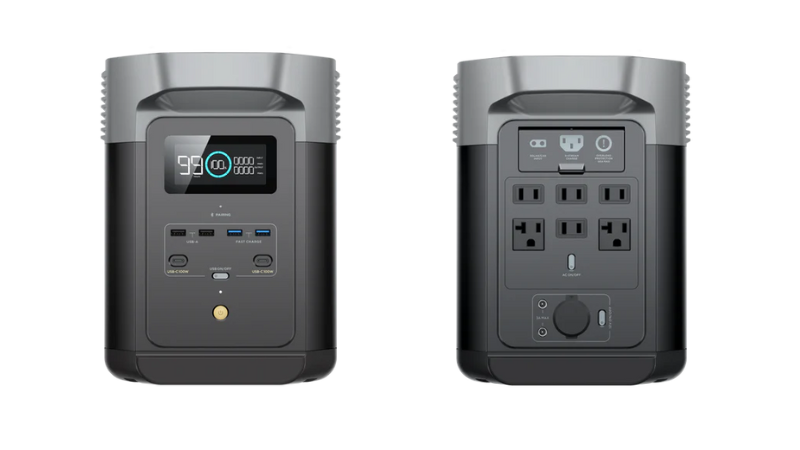
One of the biggest strengths of the Ecoflow Delta 2 is its wide variety of ports, allowing you to charge multiple devices at once.
Input Ports (Charging Options)
- 1x AC input (1200W max) – Used for wall charging.
- 1x Solar Input (500W max) – Works with portable solar panels.
- 1x Car Charger Input (12V/24V, 8A max) – For charging in vehicles.
Output Ports (For Running Devices)
- 6x AC Outlets (1800W total, 2400W X-Boost) – For home appliances like fridges, air fryers, and TVs.
- 2x USB-A Ports (Fast Charge 18W) – For phones, tablets, and accessories.
- 2x USB-A Ports (12W standard) – Slower charging for smaller devices.
- 2x USB-C Ports (100W) – Great for laptops and power-hungry accessories.
- 1x Car Power Output (12V, 10A) – To run car accessories or low-power coolers.
- 2x DC5521 Ports (12V, 3A) – Useful for specialty camping gear.
At one point, I had a coffee maker, laptop, and phone charging simultaneously, and the Delta 2 handled it without breaking a sweat.
The X-Boost technology lets it run high-wattage devices (like an electric grill) even if their power draw is slightly over the rated 1,800W limit.
4. LCD Display & Smart App: Is It Easy to Use?
The Ecoflow Delta 2’s LCD screen gives you a real-time energy insight into battery percentage, power input/output, and estimated runtime.
The interface is clean, bright, and easy to read—even in outdoor conditions.
What I Liked:
- The screen updates instantly as devices are plugged in/out.
- Shows estimated runtime based on current power draw—great for managing energy on a camping trip.
EcoFlow App:
- Bluetooth & WiFi connectivity for remote monitoring.
- Lets you adjust power settings, track usage, and check charge levels from your phone.
- Some occasional disconnections, but overall a useful feature.
5. Portability & Build: Is It Easy to Carry and Durable Enough?
Weighing 27 lbs (12 kg), the Ecoflow Delta 2 is not the lightest portable power station, but it’s manageable for short carries.
Handles & Design:
- The built-in sturdy handles make loading it into a car or RV easy.
- Compact shape—doesn’t take up much space in a trunk or tent.
Durability & Outdoor Use:
- The plastic casing feels rugged enough for daily use, but it’s not weatherproof.
- No rubberized edges, meaning you’ll need to be careful on rough terrain.
If you plan to use this exclusively outdoors, you’ll need to keep it covered in wet conditions—some competitors offer more weatherproof designs.
The EcoFlow Delta 2 delivers on most of its promises—fast charging, strong power output, and expandability make it a reliable option for home backup power and long camping trips.
Would I take it on another camping trip?
Absolutely!
But I’d pair it with extra batteries or a larger solar setup for maximum reliability.
Pros of EcoFlow Delta 2 Portable Power Station
1. Charging Speed: A Game-Changer in the Field
The Ecoflow Delta 2’s fastest charging feature proved to be a real advantage.
On the first evening, after using it to run a mini fridge, a string of LED lights, and charge my laptop, the battery dropped to around 12%. I plugged it into an AC wall outlet, and by the time I was done making breakfast the next morning, it was already over 80% charged.
That meant no downtime—just power ready to go again.
The solar charging experience was a little less predictable. On a clear, sunny day, it charged in about two and a half hours, but on a cloudy morning, it stretched past four hours.
While solar power is a great option, it’s definitely not something you can rely on for quick recharges if the weather isn’t cooperating.
For those who go off-grid often, the ability to get 80% charge in under an hour via AC is a huge advantage—it means less time worrying about power and more time enjoying the trip.
2. Effortlessly Powers Essential Appliances
My goal was to see whether the EcoFlow Delta 2 could actually handle the devices I’d use on a real trip. I wasn’t running a full home, but I wanted enough power to keep my essentials running.
I set up my mini fridge first, plugging it in at the start of the day.
It ran for nearly 19 hours straight before the battery finally needed a recharge. That alone made me trust the Ecoflow Delta 2 as a solid backup power solution—if the power went out at home, I knew I’d have enough time to figure out the next steps without worrying about food spoilage.
The coffee maker test was next.
This was non-negotiable—no power station is useful to me if it can’t handle making coffee in the morning. Plugged into the AC outlet, my standard 1,000W coffee maker brewed a full pot with zero issues. It did pull a noticeable amount of power—about 10% of the battery in a single brew cycle—but it worked exactly as expected.
Things got more interesting when I tested my portable air conditioner.
It ran smoothly for about five hours, which is just shy of EcoFlow’s claimed six hours. While not a deal-breaker, it did remind me that higher-wattage appliances drain power much faster than expected.
For overnight cooling, an extra battery would be necessary.
3. Expandable Battery Power Means Less Stress
One of the features that stands out with the Ecoflow Delta 2 is its ability to expand capacity. While I didn’t need to push it past its limits on a short camping trip, I tested an extra battery to see how much it could extend my runtime. This test is critical for extended power outages.
With the extra battery connected, I doubled my fridge runtime to nearly 36 hours, and my portable AC lasted an entire night instead of cutting off after five hours.
For longer camping trips or serious emergency preparedness, having this kind of expansion option is a game-changer.
What I liked most is that adding extra capacity is seamless—you don’t have to unplug or reset anything. Just connect the Max Smart Extra Battery, and the system automatically recognizes the increased power.
No fuss, no complicated setup.
4. Auto-Switching for Backup Power: Does It Work?
EcoFlow advertises the Delta 2 as a home backup power solution, but how well does it actually work when the power cuts out?
I tested it with my WiFi router and a lamp, then simulated a power outage by unplugging the AC power.
The transition was instant.
There was no flicker, no delay, and the router stayed online. That means if the power went out at home, the Ecoflow Delta 2 could keep essential devices running without interruption. While I wouldn’t rely on it to power an entire house, it’s definitely useful for keeping critical devices online during short outages.
5. The EcoFlow App: A Helpful, but Not Perfect, Addition
At first, I wasn’t sure how useful an app would be for a power station. But once I started using it, I found myself checking it constantly.
The real-time energy insights were especially handy—I could see exactly how much power my devices were drawing and get an estimated battery runtime. When using the solar panels, I could track input wattage in real-time, which helped me adjust panel positioning for better efficiency.
However, the app did have occasional connection issues. If I walked too far away, I sometimes had to resync manually, which was a minor annoyance. It’s a great tool for monitoring power usage, but not something you want to rely on for critical adjustments.
Cons: Where the EcoFlow Delta 2 Falls Short
No power station is perfect, and while the EcoFlow Delta 2 delivers on most of its promises, there were a few areas where it fell short in real-world use.
Some of these drawbacks may not be deal-breakers, but they’re worth considering before making a purchase.
1. The Fan Can Get Loud Under Heavy Load
I first noticed this while brewing coffee and running a laptop charger at the same time.
As soon as the power draw hit around 1,200W, the cooling fans kicked in, and they were noticeably loud—not deafening, but enough that I wouldn’t want to sleep next to it in a small room.
For camping, this wasn’t a huge problem. Outdoors, the sound blended in with ambient noise. But in a quiet cabin or home setting, it’s something to be aware of.
If you’re running a mini fridge or charging a few small devices, the fan stays quiet, but as soon as you push it closer to its 1,800W limit, expect some background noise.
2. Solar Charging Slows Down on Cloudy Days
One of the biggest reasons people invest in power stations like this is for solar charging—free, renewable energy, anytime. In perfect conditions, the Delta 2 charged up in about 2.5 hours using 500W portable solar panels.
But as soon as the clouds rolled in, charging time slowed dramatically.
On an overcast morning, it took over 4 hours to reach 80%, and on a partly cloudy afternoon, solar input fluctuated so much that charging was inconsistent. If you rely entirely on solar power, this could be frustrating. The Maximum Power Point Tracking (MPPT) system helps optimize charging, but at the end of the day, solar is only as good as the sunlight available.
For backup power at home, this isn’t a major issue since AC charging is extremely fast. But for off-grid camping, a larger solar array or an extra battery would be necessary for full-day reliability.
3. Auto Switch Works, But It’s Not Instant for Sensitive Devices
The Delta 2 is marketed as a partial home backup solution, but there’s one caveat—the auto switch isn’t quite fast enough to be a true UPS (uninterruptible power supply) for sensitive electronics.
So, it’s not a true uninterapted emergency power supply.
In my test, WiFi routers, lights, and general appliances switched seamlessly, but when I simulated an outage while running my desktop PC, it shut off for a brief second before the battery kicked in.
This means that for computers, gaming consoles, or medical devices, you’ll want a dedicated UPS instead.
For keeping basic home appliances running during an outage, though, the transition is smooth enough to trust it.
4. Is It Worth the $999 Price Tag?
There’s no getting around it—the EcoFlow Delta 2 is not cheap.
At around $999, it’s more expensive than some competitors, and when you add an extra battery, the cost jumps significantly.
That said, you’re paying for top-tier features—fastest charging in its class, expandable power, and smart energy tracking. If you just need a simple power bank for occasional use, cheaper options exist. But if you want speed, reliability, and long-term durability, the price makes more sense.
Note: EcoFlow occasionally offers sales and price cuts; it can even go for sale at just $499!
What Are the Top Competitors of the Ecoflow Delta 2?
The EcoFlow Delta 2 is a powerful, fast-charging portable power station, but it’s not the only option out there. Depending on your priorities—battery life, portability, price, or expandability—other power stations might be a better fit.
Here’s how the Delta 2 stacks up against some of its biggest competitors.
Jackery Explorer 1000 vs. EcoFlow Delta 2
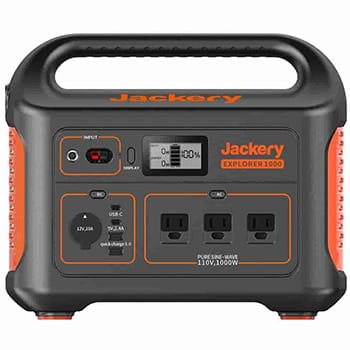
Jackery is one of the most well-known brands in the portable power station market, and the Explorer 1000 is a direct competitor to the Delta 2.
At first glance, both units have a similar battery capacity—the Jackery has 1,002Wh, while the Delta 2 offers 1,024Wh. But beyond that, they start to diverge.
The biggest difference is charging speed. Jackery’s AC charging takes over 5 hours for a full charge, while the Delta 2 hits 80% in just 50 minutes and fully charges in about 80 minutes.
Jackery does have a few advantages.
It’s lighter (22 lbs vs. Delta 2’s 27 lbs), making it easier to carry on hiking or backpacking trips.
However, its battery cycle life is shorter—after about 500 charge cycles, Jackery’s battery degrades, while Delta 2’s LiFePO4 battery lasts 3,000+ cycles.
💡 Who Should Choose Jackery?
- If weight and portability are top priorities.
- If you don’t need ultra-fast charging.
Bluetti AC200P vs. EcoFlow Delta 2
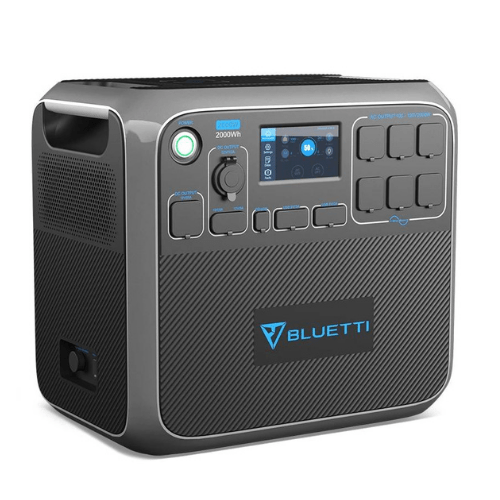
The Bluetti AC200P is for those who need more raw battery capacity.
It boasts a massive 2,000Wh battery, almost double the size of the Delta 2. However, that extra power comes with trade-offs.
First, the Bluetti is much heavier (60 lbs vs. 27 lbs)—not exactly portable. It’s more suited for home backup power rather than camping or road trips. Second, its charging speed is slower. While the Delta 2 charges in 80 minutes, Bluetti takes 3 to 4 hours for a full charge.
Where Bluetti wins is battery capacity. If you need extra capacity and don’t mind the weight, Bluetti is worth considering.
💡 Who Should Choose Bluetti?
- If weight and portability are top priorities.
- If you don’t need ultra-fast charging.
Should You Buy the EcoFlow Delta 2?
The EcoFlow Delta 2 delivers fast charging, solid power output, and expandable capacity, but is it the right fit for you? That depends on what you need.
Who Is It For?
If you need a reliable power station for camping, road trips, or emergency backup, the Delta 2 is a strong option. Its quick charging means less downtime, and its ability to run appliances like mini-fridges and coffee makers makes it highly practical. The expandable battery feature also gives it an edge for those who need extended runtime.
For homeowners, it’s a smart solution for keeping essential devices running during short power outages. It won’t power an entire home, but it can handle critical appliances.
Who Should Look Elsewhere?
If budget is your main concern, cheaper power stations exist, though they may lack the Delta 2’s speed and longevity. If you need a full-home backup system with a transfer switch, larger models like the Delta Pro or Bluetti AC200P might be a better fit.
Price vs. Performance: Is It Worth It?
At $999, the Delta 2 isn’t cheap, but it offers top-tier features—fastest-in-class AC charging, expandable capacity, and a long-lasting LiFePO4 battery.
But if you can snag one at a cheaper sale price, go for it!
If you value reliability, speed, and flexibility, it’s a great investment.
